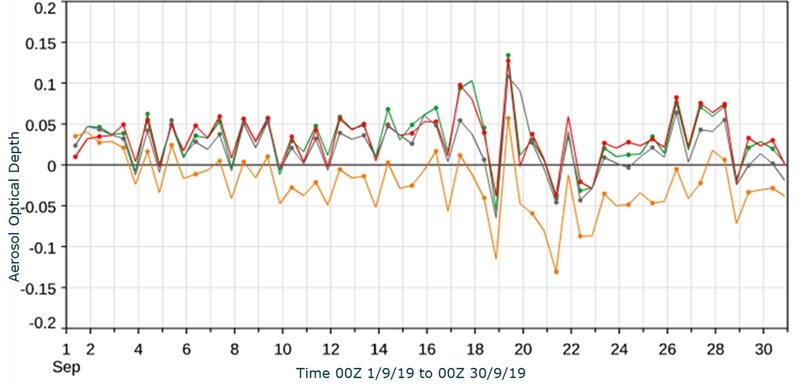Assimilating ESA CCI Aerosol dataset improves model output
Key Result
Assimilating SLSTR data gives some improvement over existing aerosol data
Assimilating ESA CCI Aerosol data reduces the bias in the ECMWF reanalysis. This improvement is seen when the data are bias corrected and thinned, uncorrected data has less impact. Further analysis is required over a longer time-period to give statistically significant results. New and improved versions of the SLSTR CCI+ AER Aerosol Optical Depth product should also be tested.
The Sea and Land Surface Temperature Radiometer (SLSTR) is the latest satellite data to be incorporated into the CCI Aerosol ECV dataset. The ECMWF Integrated Forecast System (IFS) model was run in composition configuration as used operationally by the Copernicus Atmosphere Monitoring Service (CAMS) for September 2019, assimilating a range of different Aerosol Optical Depth (AOD) data and the bias in the 500 nm Aerosol Optical Depths (AODs) was compared for the different input combinations. This bias was calculated as the difference between model AODs and that measured by the AERONET network of 238 globally distributed instruments[1].
Adding AOD data does not consistently improve the model output (Figure 1). Sometimes using no aerosol data results in the lowest bias in the spin-up period. However, adding SLSTR data to the other AOD data improves the bias in most instances, particularly towards the second half of the month, demonstrating a positive impact of the assimilated observations. The length of the timeseries is short here and more than one season should be considered before reaching firm conclusions.
SLSTR data gives a better result when thinned and biased corrected before assimilation. New and improved versions of the SLSTR AOD CCI+ product should also be tested.
[1] https://aeronet.gsfc.nasa.gov/


About the author

This case study was produced in 2022 by Angela Benedetti at ECMWF. Angela is a senior scientist and team leader in the Earth System Assimilation Section (Research Department). She joined ECMWF in October 2002 as a research consultant in cloud radar data assimilation. She was the main architect of the aerosol analysis that is now operational at ECMWF as part of the Copernicus Atmospheric Monitoring Service (CAMS) and she continues to pioneer the assimilation of new observations, such as satellite and ground-based lidar profiles of aerosol backscatter. She has also worked on the radiative impact of atmospheric aerosols on weather at the monthly and seasonal scales. More recently she has gone back to cloud assimilation and is leading an effort to assimilate visible radiances in the Integrated Forecast System.

